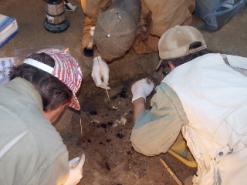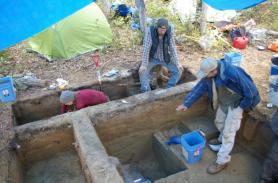Les plus anciens restes humains de l’Amérique subarctique retrouvés
Source - http://www.maxisciences.com/arch%e9ologie/les-plus-anciens-restes-humains-de-l-amerique-subarctique-retrouves_art12794.html
Datant d’environ 11.500 ans, des restes humains en partie carbonisés ont été découverts en Alaska. Ils appartenaient à l’un des premiers habitants d’Amérique du Nord.
Le squelette, en partie brûlé, d’un enfant de trois ans a été trouvé dans un ancien foyer parmi les vestiges d’une habitation se trouvant à proximité de la rivière Tanana, dans le centre de l’Alaska. D’après une datation au radiocarbone, la crémation de son corps remonte à environ 11.500 ans.
De plus, l’âge des ossements indique qu’il s’agit probablement des plus anciens restes humains trouvés à ce jour dans cette partie de l’Amérique du Nord, ainsi que ceux du second plus jeune enfant de l’âge glaciaire sur le continent. En analysant les dents de l’enfant, le bio-archéologue Joel Irish de l’Université d’Alaska a confirmé qu’il était biologiquement affilié aux Amérindiens et aux Asiatiques du nord-est. Par ailleurs, selon les chercheurs, les ossements restants, bien que calcinés en grande partie, pourraient encore contenir de l’ADN de l’enfant.
"Ce site révèle de nombreux comportements, jamais vus auparavant dans cette partie du monde durant la période glaciaire. La préservation ainsi que l'absence de perturbation du site nous permettent de voir les habitudes de vie de ces peuples anciens sous un nouveau jour", a expliqué à l’AFP Ben Potter, un archéologue à l'Université d'Alaska à Fairbanks, l'un des quatre co-auteurs de ces travaux, rendus publics hier. En effet, cette découverte va permettre de donner un éclairage exceptionnel sur les rites funéraires et les habitudes de vie des habitants des zones subarctiques nord-américaines de la fin de l’ère glaciaire.
Ce site en Alaska avait retenu l’attention particulière des archéologues. Ils y avaient déjà découvert des traces de présence humaine remontant à 13.200 ans environ.
UA Archaeologists Help Excavate Ancient Site in Alaska
Jeff Harrison - The University of Arizona Office of University Communications
Source - http://uanews.org/node/38174
Vance Holliday and doctoral student Joshua Reuther were part of a University of Alaska team that uncovered a structure dating back more than 11,000 years and reported in the current issue of the journal Science.
A team of archaeologists, including two from the University of Arizona, have discovered a rarity in the prehistory of Alaska, a dwelling inhabited at the end of the Pleistocene era when northeastern Asia and Alaska were connected, or were beginning to be separated by flooding of the Bering Land Bridge.
The dwelling, a semi-subterranean house dug partway into the ground, was inhabited some 11,500 years ago. In it also were found the cremated remains of a three-year-old child.
The group, which includes Vance T. Holliday, a professor of anthropology and geosciences at the UA, and Joshua D. Reuther, a doctoral student in the UA School of Anthropology, report their findings in the current issue of the journal Science.
Ben Potter, a professor of anthropology at the University of Alaska, Fairbanks, is the principal investigator of the site and the primary author of the Science paper. Potter also is a member of Reuther's doctoral committee.
Holliday, who co-chairs Reuther's doctoral committee, is also the executive director of the UA-based Argonaut Archaeological Research Fund that focuses on the archaeology of the earliest inhabitants of the Southwest.
Based on his experience with Paleoindian archaeology and geoarchaeology in the lower 48 states, Holliday was asked in for part of the field work done in August 2010. Reuther, who has completed his anthropology and geosciences course work at the UA, divides his time between the UA and Northern Land Use Research, Inc., a private archaeology firm in Alaska.
Reuther's dissertation is based on sites in interior Alaska that date back more than 13,000 years ago. He is a collaborating with several archaeologists, ecologists, geologists and paleolimnologists to understand the geological and paleoecological changes during and subsequent to the retreating glaciers in the region. The goal is to understand how these changes relate to the initial human colonization and subsequent land use there.
The Upward Sun River site was discovered as part of a larger scale cultural resource management field survey conducted in 2006-07 by Northern Land Use Research.
Reuther was one of the field directors for the excavation. His work on the geoarchaeology, environment and stone tools at the site are part of the article in Science.
Potter secured funding from the National Science Foundation to continue the excavation and geoarchaeological investigations early in the summer of 2010. That is when the cremation was discovered.
Potter collaborated with local Native American groups to go back and excavate the cremation in August. During that excavation the team realized that the cremation was inside a pit, probably used as a hearth, that was part of a semi-subterranean structure.

Joshua Reuther, Ben Potter and Joel Irish excavate the burial pit at the Upward Sun River site in Alaska. (Photo courtesy Ben Potter)
The pit house contained a variety of stone tools and animal remains, such as squirrels and salmon, that suggested it was occupied during mid-summer periods.

Josh Reuther (seated) and University of Alaska professor Ben Potter (right) examine the pit house they excavated at the Upward Sun River site in Alaska. (Photo courtesy Vance Holliday)
"Most of our sites are camp sites occupied for short periods of time, sites where processing of game occurred, and sites where stone tool manufacturing and maintenance occurred," Reuther said.
The remains of the child, which were found at the top of the hearth, indicates that the structure was permanently abandoned after the burial.